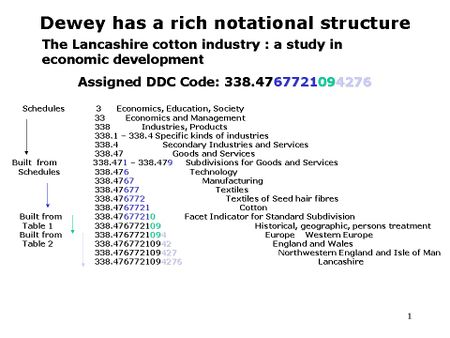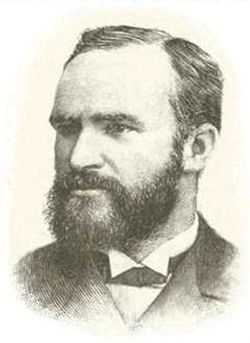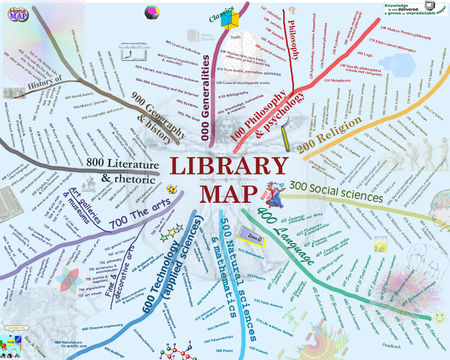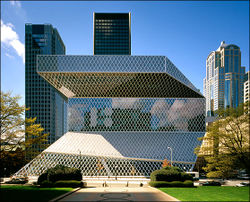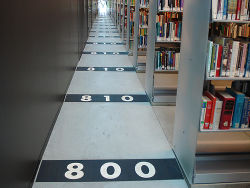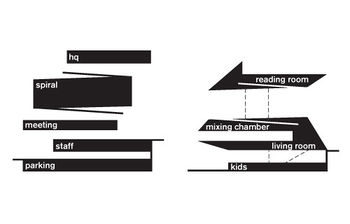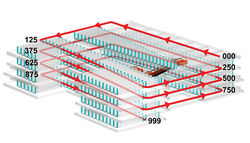Dewey Decimal System
The Dewey Decimal System is a hierarchical system of classification that utilizes decimals to codify divisions. Despite its decreasing popularity, Dewey continues to be the most dominant classification system in the world and is used in over 138 countries and 200,000 libraries.
Contents
Utility
Main Classes
Each of the 10 below main categories has 10 secondary categories within which there are another 10 subcategories.
▪ 000 – Computer science, information & general works
▪ 100 – Philosophy and psychology
▪ 200 – Religion
▪ 300 – Social sciences
▪ 400 – Language
▪ 500 – Science (including mathematics)
▪ 600 – Technology/Applied Science
▪ 700 – Arts and recreation
▪ 800 – Literature
▪ 900 – History, geography, and biography
Revisions
Melville Dewey (December 10, 1851 – December 26, 1931)
Alternatives
MARC AACR2 LC Subject Headigns Sears Subject Headings
Current Issues
Perry Branch Rebellion
Seattle Central Library
The spectacle that became the Seattle Central Library was the results of both a Seattle Public vote for "Libraries for All" and a $20 million donation by Bill Gates. Rem Koolhaas and Joshua Prince-Ramus of the Dutch firm Office for Metropolitan Architecture (OMA) were the principal architects on the project. The building has been described as a celebration of books with the form dictated by the medium. The Book Spiral, which houses the nonfiction collection, can be found on floors 6 to 9. The floors aren't separated by stairs, but rather are built on a slight incline, allowing the collection to be enjoyed without interruption. The Spiral is organized by the Dewey Decimal System, starting with 000 and working upwards with each foot. In making the decision to design a building around the Dewey Decimal System, the Seattle Central Library has made the classification more durable, pouring it into cement.
The Bookstore Model
Browsing versus finding
Metadata
Databases now must catalogue and increasing amount of nontextual information such as images, sounds, videos, and scanned documents. These types of information require multidiscipilary forms of classification and search. These kinds of networks represent the future of broad classification systems.
Music Classification
Sources
Clyde, Anne "Metadata. " Teacher Librarian 30.2 (2002): 45-47. Research Library, ProQuest. Web. 28 Nov. 2010.
Drabinski, E.. "Gendered S(h)elves: Body and Identity in the Library. " Women & Environments International Magazine 1 Oct. 2009: Research Library, ProQuest. Web. 28 Nov. 2010.
El-Sherbini, Magda "Metadata and the future of cataloging. " Library Computing 1 Jan. 2000: ABI/INFORM Global, ProQuest. Web. 28 Nov. 2010.
Fialkoff, Francine "It's Not About Dewey. " Library Journal 1 Nov. 2009: ABI/INFORM Global, ProQuest. Web. 28 Nov. 2010.
Fister, Barbara "The Dewey Dilemma. " Library Journal 1 Oct. 2009: ABI/INFORM Global, ProQuest. Web. 28 Nov. 2010.
Goldberg, Beverly "Classification clash. " American Libraries 1 May 2001: Research Library, ProQuest. Web. 28 Nov. 2010.
Ketcham, Susan. "Learn Library of Congress Classification / Learn Dewey Decimal Classification (Edition 21). Library Journal 1 Feb. 2000: ABI/INFORM Global, ProQuest. Web. 28 Nov. 2010.
Kidwell, Claire "Music Classification Systems. Library Review 52.5/6 (2003): 279-280. Research Library, ProQuest. Web. 28 Nov. 2010.
Prescott, Sarah. "If you knew Dewey... " School Library Journal 1 Aug. 2001: ABI/INFORM Global, ProQuest. Web. 28 Nov. 2010.
Stevens, Norman D. "The catalogs of the future: A speculative essay. " Information Technology and Libraries 17.4 (1998): 183-187. ABI/INFORM Global, ProQuest. Web. 28 Nov. 2010.
Tapper, Janet "Dewey Does a Number on Wicca. " Library Journal : Spiritual living 1 May 2006: ABI/INFORM Global, ProQuest. Web. 28 Nov. 2010.
